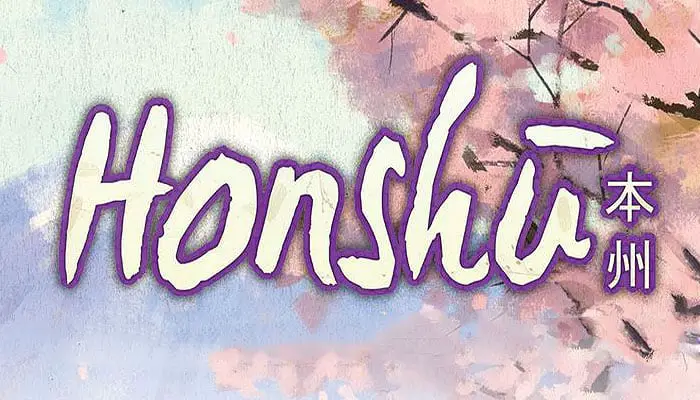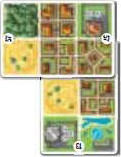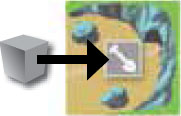
Honshu is a trick-taking, map building card game set in feudal Japan. Players are lords and ladies of Noble houses seeking new lands and opportunities for fame and fortune.
One game of Honshu lasts 12 rounds, and each round is divided into two phases.
First, Map cards are played in a trick and the player who played the highest valued card gets to pick first from those played. Then the players use the Map cards picked to expand their personal maps. Each player must expand their personal maps to maximise their scoring possibilities.
Manipulating your position in the player order is crucial for mastering Honshu.
Components
- 40 Resources (10 blue, 10 brown, 10 grey, and 10 yellow).
1 - 6 Starting Province cards (The A-sides are identical and guarantee an equal setup while the B-sides provide an asymmetric setup for the players).
2 - 60 Map cards numbered 1 through 60
3 - 8 End of Game Scoring cards
4 - 5 Player Order cards
5 - 5 Scoring Summary cards
6

Setup
Place the resources in the center of the playing area in a common pool 1.
Decide which side of the Starting Province cards you're going to use, then deal one random Starting Province card 2to each player with the chosen side face up. Place a matching resource on each of the production squares found on the Starting Province cards. The Starting Province card is the first card in each player's respective map.
Deal one random Player Order card 3 and one Scoring Summary card 4 face up to each player.
Shuffle e all the Map cards and deal 6 to each player face down as their starting hand 5. The rest of the Map cards form a draw pile 6. You are now ready to play the game.

Game Play
The game is played over 12 rounds. Each round consists of a Trick-Taking Phase and a Map Phase.
Trick-taking Phase (3 To 5 Players)
Each Trick-Taking Phase is played in ascending player order (Player Order cards: 1, 2, 3.)...
The cards played in the trick determine the order of picking the played Map cards.
Playing A Trick
Following the player order, the players play one Map card from their hands face up on the playing area. When the players play Map cards in this fashion, they may add a single resource from their production squares to the Map card. The first resource played in a trick can be of any type. Any further resources played in the same trick must be of the same type. A resource on a Map card increases its value by 60.
After all players have played one Map card and a possible resource, a new player order is determined. The Player Order cards are given to players in descending order of the total values of the played Map cards (see the example below).
In the new player order, every player takes one of the Map cards on the playing area and moves to the Map Phase. The used resources are returned to the common pool.

Example: Jack played Map card #11.
Mary played card #29 and a blue resource (=89).
Chris played card #57 with a resource (=117), (blue because Mary already played a blue resource).
Lisa played card #59. Chris is the new first player, Mary is 2nd. Lisa is 3rd and Jack is 1th.
Map Phase

In the Map Phase, the players expand their maps by placing the card they acquired in the previous Trick-Taking Phase. Each player must place their Map card in their respective map in such a way that at least one square of the new card is either on top of or hidden under a previously placed Map card, and at least one square of the new card remains visible.
Exception: Lake squares must always be visible and cannot be hidden.
A single matching resource is placed on each production square of the newly placed Map card. If a player places a card on top of a production square which still has a resource, that resource is discarded to the common pool.
Consecutive Rounds

The player with the Player Order card #1 starts the Trick-Taking Phase of a new round by playing a Map card from their hand.
Exceptions:
After the third round, the remaining three Map cards in the players' hands are given to the player on the left.
After the sixth round, deal six Map cards from the draw pile to each player face-down as their new hand.
After the ninth round, the remaining three Map cards in the players' hands are given to the player on the right.
After 12 rounds the game ends and the final scoring takes place.
2 Player Trick-taking Phases
In the beginning of each Trick-Taking Phase, two Map cards are revealed from the draw pile. These cards form a pair. Then both players simultaneously reveal a Map card they want to play from their hand. These two cards form a second pair.
The player who played the higher valued Map card wins and decides which pair he wants. However, before the winner can take the cards, the loser may choose to remove any two resources from their own map and take either of the pairs instead. The pair that was not chosen goes to the other player. Then each player discards one card from the pair and begins the Map Phase with the card left in their hand.
Different Area Types On The Map Cards
Forest:

In the final scoring, each visible forest square is worth  .
.
Town:

In the final scoring, each town square is worth a  , but only the biggest town district of each player is counted.
, but only the biggest town district of each player is counted.
Production Squares:

During the Map Phase, each new production square receives a matching resource on its space. Resources can be used in the Trick-Taking Phase to increase the card value by 60, or delivered to matching factories during the final scoring.
Factory:

In the final scoring, each unused resource can be scored by moving it to a matching factory
for  /
/ /
/ . Only one resource per factory.
. Only one resource per factory.
Lake:

In the Map Phase, lakes cannot be placed under another Map card and must always be visible. In the final scoring, each lake district is counted. The first lake square in each lake district is worth 0  , while each consecutive square in the district is worth
, while each consecutive square in the district is worth  .
.
Fallow:

Fallows have no eff ect on the gameplay. They are only used as a tie-breaker in the final scoring.
OPTIONAL RULE: END OF GAME SCORING CARDS
At the beginning of the game, reveal one End of Game Scoring card. Each player will score the points indicated on the card as described below:
1: You may deliver two resources instead of one to each factory.
2: Each row or column of three consecutive forest squares gives bonus of  .
.
3: Each 2x2 block of fallows is worth 
 .
.
4: Each lake square is worth  instead of the normal scoring.
instead of the normal scoring.
5: Each town square adjacent to exactly 4 other town squares is worth  .
.
6: Each visible and empty production square is worth  .
.
7: Each blue and/or yellow resource in a factory is worth extra  .
.
8: Each grey and/or brown resource in a factory is worth extra  .
.
FINAL SCORING
Players score their maps based on their visible factories, forests, lakes, and towns.
For each forest square the players score  .
.
For each town square the players score a  , but only the biggest town district of each player is counted. A district consists of all orthogonally adjacent squares of the same area type.
, but only the biggest town district of each player is counted. A district consists of all orthogonally adjacent squares of the same area type.
For each factory which can be given a resource from a matching production square the players score  /
/  /
/  .
.
The first lake square of each lake district is worth 0  and each consecutive square is worth
and each consecutive square is worth  .
.
The player who has the most  wins the game.
wins the game.
In case of a tie, the player with the highest number of visible fallows wins the game.

Continue Reading

